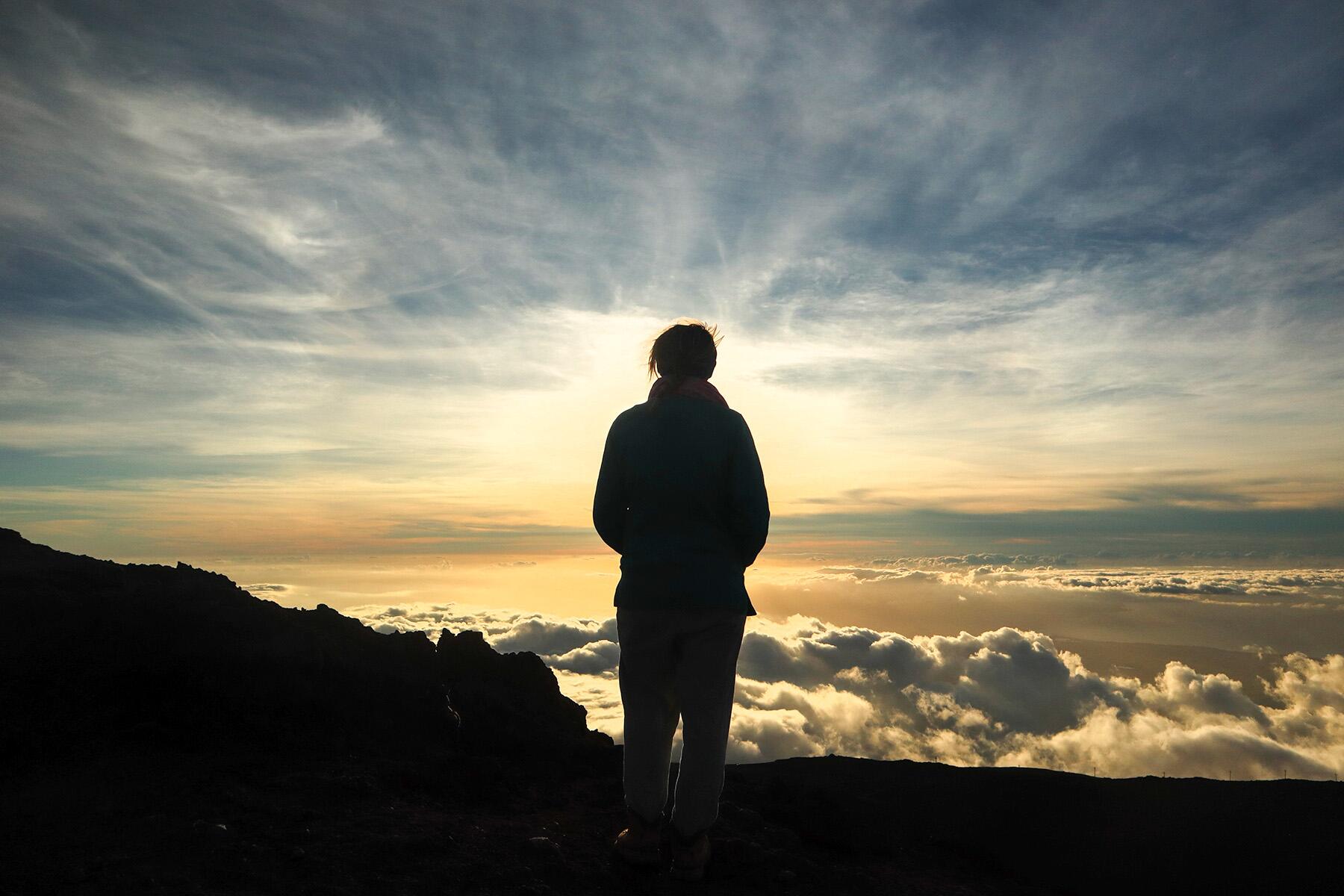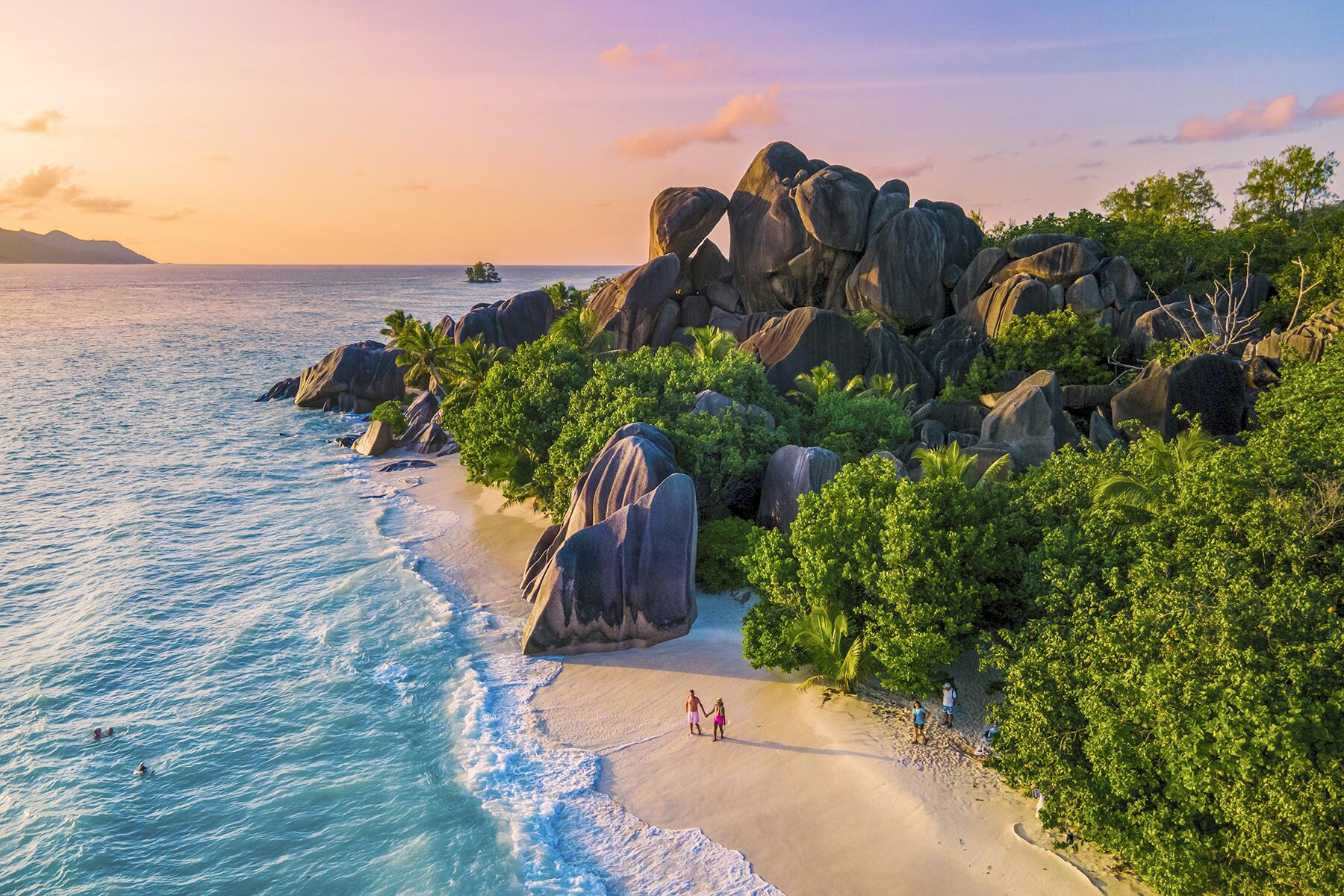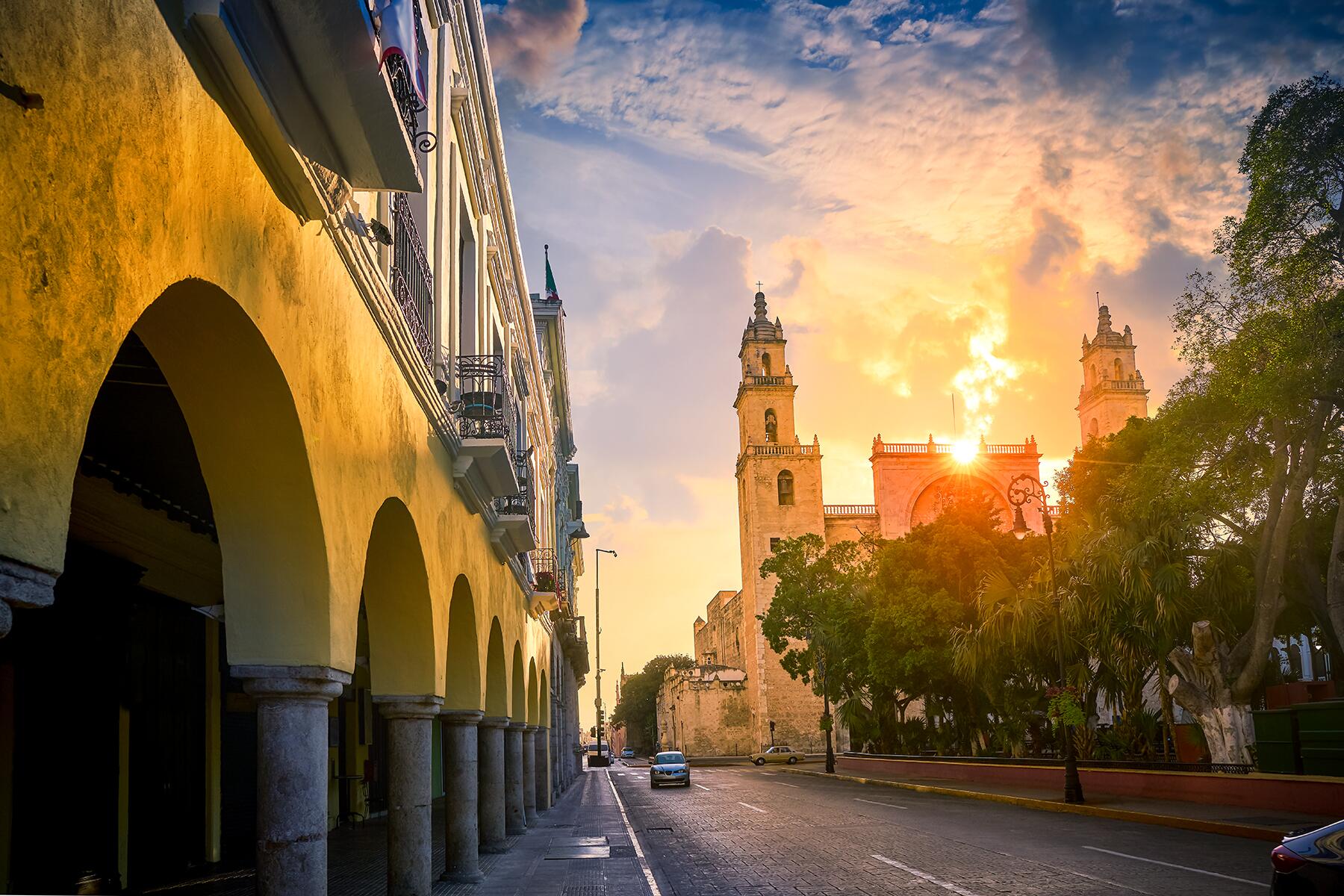Dive into an underwater sinkhole, enjoy a slow-cooked Yucatecan meal, or book a stay at a colonial mansion.
For decades, Yucatán State and its capital city of Mérida have been favorite getaways for Mexican vacationers, and with good reason. Yucatán State shares a peninsula with more touristy destinations like Cancún and Tulum, but exploring Mérida and its surrounding beaches, jungle, and small towns is a pleasantly low-key travel experience. Expect a visit that’s equal parts gorgeous tropical jungle and chic city life, Yucatecan cuisine and colonial architecture and history, and perhaps the most splendid Mayan ruins in the region. These are the best things to do in Mérida and Yucatán.
Plan Your Trip: Visit Fodor’s Mérida Travel Guide and Fodor’s Yucatán Travel Guide. Additionally, you can fly directly into Mérida Airport, or make the three-hour trip from Cancún airport via rental car, or the comfy ADO bus. ADO buses are a reliable and easy option for traveling within Yucatán State.
Top Picks for You
Take a (Luxurious) Step Back in Time at an 18th Century Hacienda
WHERE: Yucatán State
Once country estates and agricultural hubs (producing henequen, a plant cultivated for its fiber), many haciendas in the rural area around Mérida have been restored as boutique hotels, fantastic restaurants, spas, and gorgeous grounds for touring. Hacienda stays or visits can be combined with stops to cenotes, ruins, or return trips back to Mérida. Even if you don’t spend a night at a hacienda, the historical architecture and beauty is worth a stop on the way elsewhere.
Hacienda Teya, built in 1683 first as a cattle ranch, and later a henequen farm, is best known for its Yucatecan cuisine, but the intimate suites and beautiful baroque buildings make it an excellent stay as well. With a pool, lush garden, and spa, Hacienda Xcanatun feels like an elegant summer estate just 20 minutes from Mérida. At Hacienda Sotuta de Peon, tour the production of henequen the traditional way: in carts pulled by mules.
Slow Down in Valladolid
WHERE: Valladolid, Yucatán
One of Yucatán’s premiere pueblos magicos (Mexico’s unique and culturally-rich “magic towns”), the city of Valladolid makes a great stop on the way to Chichén Itzá, a home-base for visiting ruins, or a side trip from Mérida. Surrounded by 16th-century architecture, religious buildings and brightly colored mansions, Mayan language, food, and design still permeate the area. Daily pleasures in Valladolid include spa treatments, filling Yucatecan meals, shopping, and dips in the nearby cenotes, Zaci, Samula, and X’kekén. Stay at hotel El Meson del Marques, the charming colonial home-turned-inn of Casa Tia Micha, or the Valladolid branch of the luxe Coqui Coqui Perfumeria and Spa. The Mexican folk art collection at Casa de Venados is a must-see, and there are markets and stores with artisanal goods around the main plaza. After touring the former San Bernardino Convent, dating back to 1552 as one of the oldest colonial structures in the Yucatán, enjoy a Yucatecan meal at Taberna de los Frailes.
Recommended Fodor’s Video
Dive Into the Yucatán’s Underground Treasures
WHERE: Yucatán State
Cenotes are an underground network of limestone sinkholes filled with water, once highly revered and utilized by the Mayans. These cavernous, photogenic swimming areas—widespread in the Yucatán peninsula, but seldom found elsewhere in the world—are the premier natural wonder of the Yucatán. Some cenotes are more hidden than others, accessed by tunnel or narrow hole into the ground, while others are open-air. A few cenotes, like Zaci in Valladolid, are public and easy to find, but the best are private and should be toured with a guide. You’ll explore more fascinating and less crowded cenotes this way. Select cenotes allow guided scuba diving expeditions.
Lawson Yucatán Excursions arranges private, personalized tours that can combine a few cenotes, lunch at a hacienda, and a trip to Mayan ruins. The Yucatecan guides are knowledgeable and friendly, and the ease can be worth the expense if you’re traveling with a group. The adventurous Seven Cenotes Tour is another good option.
Taste the Flavors of Yucatecan Cuisine
WHERE: Mérida and the Yucatán State
Staples of Yucatán’s cuisine are tortillas, beans, and slow-cooked meats, but the flavors and preparation of these dishes are tasty and unique to the region. Cochinita al pibil is a regional specialty: slow-cooked, tender pork roasted in a citrus and achiote (annatto seed) marinade. At cantinas and casual restaurants, you’ll find panuchos and salbutes, two fried tortilla iterations with cheese, beans, and other tasty toppings. On the coast, in towns like Progreso and Celestùn, the best meal you’ll have is at a nondescript, off-the-beaten-path seafood shack (look for outdoor grills, plastic tables, and boats pulling in nearby), where grilled or fried whole fish is served with salsas, vegetables, and tortillas.
You can happily graze on street snacks and casual Yucatecan staples the entire time in Mérida (plan to stop for tacos at least once at Wayan’e), but if you make one dinner reservation, make it at Apoala, one of the most incredible meals to be had in Mérida. Apoala’s inventive cuisine (and cocktails) are based on classic Yucatecan ingredients and flavors, and outdoor tables on the Parque de Santa Lucia make for excellent dining on a warm evening. It’s affordable enough that you can fill your table with many of the tasty starters and mains (we recommend this).
INSIDER TIPAfter dining at Apoala, ask your friendly server to take you around back to the restaurant’s hidden speakeasy and cocktail bar.
Explore the Markets of Merida
WHERE: Mérida, Yucatán
After tasting the best cuisine at Mérida restaurants, explore the markets, both for cheap Yucatecan meals and ingredients for your own kitchen creations. Some of your best meals will be had at one of the plastic tables at the market: treats like sopa de lima (a nourishing chicken soup), panuchos, elote (corn on the cob dressed with mayonnaise, cheese and chile powder) and esquite (elote, deconstructed in a cup). There are dried chiles and spices to take home, sweets, and homemade tortillas for snacking. Even if you purchase nothing, walking through the food markets in Mérida (and most cities) is a pure delight of sights and smells. Food markets can be found off of most plazas in Mérida. Mercado Lucas de Galvez, near Plaza Grande, is a great place to start. For further exploration, take a cooking class and market tour with a local guide.
Walk the Sacred Grounds of Chichén Itzá
WHERE: Chichén Itzá
Yucatán State boasts some of the largest, best preserved and most important ancient ruins in all of Mexico. One of the “New Seven Wonders of the World” (and an UNESCO World Heritage Site) is the Mayan city of Chichén Itzá, a key player in understanding Mayan culture, and enforcing mysteries about the ancient peoples. The massive archaeological grounds are dominated by the pyramid temple of Kukulcan, the feathered serpent god. The pyramid is truly impressive in size and wonder, but there’s much, much more to see and many visitors spend a few days touring the ruins. There are hotels near Chichén Itzá, and several buses from Mérida and Valladolid will take you there in 1-2 hours.
Marvel at the Pyramid of the Magician at Uxmal
WHERE: Uxmal, Yucatán
Another UNESCO World Heritage Site, the Mayan town of Uxmal is a well-preserved display of their advanced society and Late Classic architecture. With some construction dating back to 700 AD, ancient ruins include the Pyramid of the Magician, Governor’s Palace, and a ball court. If you’re coming to Uxmal from Mérida, there are several haciendas, home-cooking restaurants, and cenotes along your way. There are hotels and small resorts around Uxmal if you wish to stay the night.
Discover Lesser-Known Ruins Along the Ruta Puuc
WHERE: The Yucatán State
Looking for more? Either by car or tour, you can follow the Ruta Puuc south from Mérida through rural hills of Yucatán, where a series of lesser-known (but still impressive) ruins begin at Uxmal, then continue to the sites of Kabah, Sayil, Xlapak, and Labna. The ruins include large palaces (many you can climb inside and explore) and are mostly in very good condition.
As adventurous as it sounds (and feels!) to explore rural Yucatán and five Mayan ruin sites on your own, the drive is actually quite easy to navigate. It’s under 20 miles total and plausible for a busy day trip from Mérida or a slower weekend. There are b&bs and eco-hotels, grocery stores, and basic Yucatecan restaurants in the town of Santa Elena, about halfway along the route, as well as around Uxmal.
Explore the Cultural Crossroads of the Yucatán
WHERE: Mérida, Yucatán
Spanish, Mayan, and waves of American expats are only some of the cultural influences on the Mérida of today. In the early 20th century, many Syrian-Lebanese (then part of the Ottoman Empire) immigrants settled in Yucatán, arriving on ships through the port at Progreso. Much earlier in Merida’s history, Spanish colonists brought Moorish and Islamic traditions as well, influencing the architecture and introducing food like chickpeas, parsley, and certain fruits to Yucatán. Mexico’s delicious al pastor (marinated shaved pork) has middle eastern origins; Mexicans adopted the method of cooking meat on a spit from Middle Eastern traditions for cooking gyros or shawarma. In Mérida and Yucatán, Lebanese immigrants are to thank for the presence of Grape leaves in Mérida cuisine, kibi or kibbeh (fried, stuffed, wheat or bulgur balls), and Mérida’s tacos arabe (served on pita bread instead of tortillas).
Arab descendants own many businesses throughout contemporary Mérida. Lebanese merchants brought Mérida its first department store, with fine imported goods and textiles not previously seen in the Yucatán. Elsewhere there is a Lebanese social club (Club Libanés de Mérida), Lebanese church, and many casual Middle Eastern restaurants.
Tour Merida’s Colonial Architecture
WHERE: Mérida, Yucatán
The Yucatan is quite old: the presence of Maya society in Yucatán dates back to 2600 BC, and the first Spanish conquistadors arrived in the 16th century. In Mérida’s main plaza, on top of old Mayan ruins (as was widely the practice), the Mérida Cathedral is one of the first in the Americas, second only to one in the Dominican Republic. The former home of Francisco de Montejo, one of the first conquistadors of the Yucatán, is also located on the main plaza. The historical mansion is now a museum preserved in time, complete with ornate furniture and art and history lessons. Both the cathedral and mansion can be toured inside.
Elsewhere in Mérida, the colonial architecture (colorful buildings with impressive facades) were constructed more recently, in the 18th and 19th centuries. Today, many former mansions and colonial homes are now restaurants, shops, and boutique hotels, the private walled courtyards at their center utilized for romantic dining or spa services. The Mérida Office of Tourism gives free walking tours of the city’s historic district.
INSIDER TIPMérida’s streets are numbered, but even-numbered streets run perpendicular to odd-numbered ones. Once you get used to the slight oddity of being on the “corner of Calle 50 and Calle 49,” the grid-like layout makes it quite easy to find your way around.
Befriend a Flamingo in Celestún
WHERE: Celestún, Yucatán
An hour and a half from Mérida, the adorable coastal fishing village of Celestún feels much farther from the commercial frenzy of Cancún than it actually is. The fishing town gives access to an incredible estuary and nature reserve, home to Celestún’s iconic pink flamingos. Take a boat out to feel among the flock: you’ll find a tour guide waiting for you on the main beach. Choose any beachside palapa for a beer and meal after, but the restaurants La Playita and La Palapa are especially good for ceviche and seafood. Most lodging choices in Celestun are casual beach hotels and guesthouses. For a full eco-resort experience, book the Hotel Xixim.
Go Plaza-Hopping
WHERE: Mérida, Yucatán
The heart of each Mérida neighborhood is its plaza, a central square that always includes a park, with welcoming benches and trees, a church, shops, restaurants, and weekly food and art markets. Mérida plazas highlight the best of the city: impeccably clean and well-planned public areas full of friendly people, good food, and live entertainment. Plaza Grande is the largest plaza and the center of the city, both socially and in size, but Plaza Santa Lucia and Santa Ana also have their draws. At night in each of these plazas, you’ll find street vendors, outdoor restaurant tables full of mingling locals, and frequent live music, dance, and light shows.
Embrace Cantina Culture (With a Beer and Mezcal in Hand)
WHERE: Mérida, Yucatán
There’s a cantina on almost every corner in Mérida (a casual bar to enjoy drinks and botanas, snacks), but not all cantinas are created equal. This is just more of a reason to try out as many as you can, but a few are not to be missed.
What started as a term for a watering hole frequented by working-class men only, cantina has become more of a general term for a bar. Still, some of the hybrid or hipster cantinas in Mérida are the most fun to visit. The courtyard of La Negrita Cantina is packed day and night with boisterous groups of locals and visitors sampling mezcal, munching on Yucatecan botanas, and enjoying live music. El Cardenal Cantina is one of the oldest in the city, dating back over 100 years, but enters the modern era with hip vibes, artisanal mezcals for the tasting and cocktails. La Perdida Cantina, near the Centro, embraces more of a traditional cantina-style.
Later into the evening, nightlight lovers must experience a night of dancing and (more) mezcal cocktail sipping among Mérida’s young and hip at Mezcaleria La Fundación or Cara Negra.
INSIDER TIPCantinas historically prohibited women, children and men in uniform from entering. Now they are open for all, but some still can be less welcoming to women and tourists. Stick to the Centro and popular neighborhoods, and follow your instincts.
Make It a Beach Day in Progreso (But Avoid the Cruise Crowds)
WHERE: Progreso, Yucatán
This low-key beach experience transforms into a commercial frenzy of hawkers and sunburnt tourists when a cruise docks here. The cruise crowds, while unpleasant, disperse quickly (Carnival cruises typically dock mid-week and only spend the day at the port), and Progreso is otherwise a chill, affordable beach trip easy to access from Mérida by city bus or car. A walk past the main beaches of Progreso reaps rewards, with small seafood shacks for lunch, views of the beach and Progreso’s long pier. Along the main stretch of beach are affordable dining options, serving fresh squid, shrimp, and ceviche, generous beach cocktails, and micheladas. Hotels in Progreso are simple but very affordable.
Shop for the Cultural, the Hip, and the Quirky in Mérida
WHERE: Mérida, Yucatán
Shops in Mérida range from high-end goods to fun tchotchkes, and everything in between. You can stroll Paseo de Montejo for your fill of boutiques and local department stores, but don’t miss the chic shops at Casa THO, the scents at Coqui Coqui, and folk art at Casa de Las Artesanías, if you’re looking for elegant gifts and wares.
Throughout shops in Mérida, you’ll see traditional guayabera shirts, also known as camisas de yucatan. Better-quality guayaberas are usually sold on their own, and you can find cheaper ones alongside artisanal goods in stores and markets around the main plazas. Some of the best places to hunt for crafts are near the Parque de Santa Lucia, at the Bazar de Artes Populares (on Saturday mornings), and Artesenaria, on Calle 60.
Book a Colonial Mansion
A house rental in Mérida offers more than a practical base: many of the colorful colonial mansions are now rental properties owned by locals and expats, and available for your vacation stay. Other historic mansions have been turned into boutique hotels or b&bs—and then there are these luxurious private haciendas, for a next-level group trip. Staying in a grand Mérida home provides a glimpse into the city’s past elegance, with walled interior courtyards (often with small swimming pools), ceramic tiles floors, canopy beds and walls filled with Yucatecan art and artifacts. Most houses come with cleaning services and other modern amenities like wifi, tv and security systems.
Discover the Heart of Gold of the Yellow City
WHERE: Izamal, Yucatán
This “pueblo magico” is picturesque and unique for the fact that most of its buildings are painted ochre, dubbing it the “Yellow City.” Izamal is less packed with sites than other Yucatecan destinations, but it’s a short, inexpensive trip from Mérida by colectivo or ADO bus, and makes for a charming day trip or short stay. There’s plenty of colonial Spanish architecture in Izamal, but Mayan culture is at the city’s heart. Once an ancient Mayan city, there are still a few small ruins (including a pyramid you can climb) a short distance from each other near the center. A long, ochre-painted monastery and church from the 16th century, plaza and park now make up the town’s center, where you’ll also find hotels, restaurants, a market, and a small folk art museum.
Stroll Paseo de Montejo
WHERE: Mérida, Yucatán
The largest avenue in Mérida is often compared to the Champs-Élysées in Paris, with its Monumento de la Patria dominating the central roundabout, palatial mansions, and wide, tree-lined avenues for strolling. On Sunday mornings, the historical district of Paseo de Montejo is closed to cars for the BICIRUTA, when Mérida families flood the streets on bikes, trams, and rollerblades. There are two shops off of the Paseo where you can rent bikes and join in on the fun: Renta de Bicicletas (Calle 43 479B), and BICI Merida (Calle 56-A 495B). Any time of day or night, stroll the Paseo at leisure, past historic buildings, shops, restaurants, and hotels.
Unlock the Origins of the Yucatán at the Grand Museo de Mundo Maya
WHERE: Mérida, Yucatán
Traveling the Yucatán leaves you with a deep respect for the indigenous cultures that, hundreds of years ago, laid the foundation for the land’s cultural landscape today. An afternoon spent at the Mayan World Museum of Mérida lends context and historical information to the ruins you’ll tour in places like Chichén Itzá. The museum’s unique modern construction is based on the Mayan idea of three worlds: sky, earth, and underworld. With a permanent collection containing over 1,000 Mayan artifacts and several rotating exhibits, it contains a multitude of examples of Mayan art and artifacts throughout the periods, as well as Spanish colonial diaries and drawings. The museum is open daily and entrance for tourists is Mex$150 (about $8 USD).
Indulge in a Spa
WHERE: Mérida, Yucatán
There’s an opportunity for luxurious relaxation in Mérida, whether its a stay at one of these beautiful boutique hotels, cocktails poolside, a decadent meal on the patio, or a day spent at one of their spas. The spa at Rosas y Xocolate, a romantic boutique hotel on Paseo de Montejo, incorporates its chocolate and roses theme into traditional and holistic spa treatments, with cacao salt scrubs, chocolate hand and feet wraps, and rose and oil massages. Coqui Coqui is a perfumerie as well as one of the chicest hotels in Mérida, and the perfumerie uses signature scents in its divine spa treatments, taking place inside a peaceful inner courtyard with an outdoor bath. The sp







